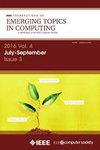编辑专题:面向人在环网络物理系统的新兴边缘人工智能
IF 5.4
2区 计算机科学
Q1 COMPUTER SCIENCE, INFORMATION SYSTEMS
IEEE Transactions on Emerging Topics in Computing
Pub Date : 2025-03-07
DOI:10.1109/TETC.2024.3472428
引用次数: 0
摘要
边缘人工智能(AI)使我们能够部署分布式AI模型,优化计算和能源资源,最大限度地减少通信需求,最重要的是,满足物联网(IoT)应用的隐私要求。由于数据保留在终端设备上,只有模型参数与服务器共享,因此可以在不损害用户隐私的情况下利用从智能手机和物联网设备收集的大量数据。然而,联邦学习(FL)解决方案也有众所周知的局限性。特别是,随着解释人类行为的系统变得越来越重要,未来的技术需要适应人类的行为。事实上,我们已经见证了前所未有的技术进步,使我们的工具和设备具有智能、感官能力和通信功能。与此同时,计算能力小型化的持续进步使我们能够远远超越简单的标记和识别,将计算资源直接集成到这些对象中,从而使我们的工具“智能化”。然而,将人类视为这些物联网驱动的网络物理系统的组成部分的科学工作有限。本文章由计算机程序翻译,如有差异,请以英文原文为准。
Editorial Special Section on Emerging Edge AI for Human-in-the-Loop Cyber Physical Systems
Edge Artificial Intelligence (AI) enables us to deploy distributed AI models, optimize computational and energy resources, minimize communication demands, and, most importantly, meet privacy requirements for Internet of Things (IoT) applications. Since data remains on the end-devices and only model parameters are shared with the server, it becomes possible to leverage the vast amount of data collected from smartphones and IoT devices without compromising the user's privacy. However, Federated Learning (FL) solutions also have well-known limitations. In particular, as systems that account for human behaviour become increasingly vital, future technologies need to become attuned to human behaviours. Indeed, we are already witnessing unparalleled advancements in technology that empower our tools and devices with intelligence, sensory abilities, and communication features. At the same time, continued advances in the miniaturization of computational capabilities can enable us to go far beyond the simple tagging and identification, towards integrating computational resources directly into these objects, thus making our tools “intelligent”. Yet, there is limited scientific work that considers humans as an integral part of these IoT-powered cyber-physical systems.
求助全文
通过发布文献求助,成功后即可免费获取论文全文。
去求助
来源期刊

IEEE Transactions on Emerging Topics in Computing
Computer Science-Computer Science (miscellaneous)
CiteScore
12.10
自引率
5.10%
发文量
113
期刊介绍:
IEEE Transactions on Emerging Topics in Computing publishes papers on emerging aspects of computer science, computing technology, and computing applications not currently covered by other IEEE Computer Society Transactions. Some examples of emerging topics in computing include: IT for Green, Synthetic and organic computing structures and systems, Advanced analytics, Social/occupational computing, Location-based/client computer systems, Morphic computer design, Electronic game systems, & Health-care IT.
 求助内容:
求助内容: 应助结果提醒方式:
应助结果提醒方式:


